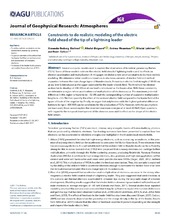| dc.contributor.author | Skeltved, Alexander Broberg | |
| dc.contributor.author | Østgaard, Nikolai | |
| dc.contributor.author | Mezentsev, Andrey | |
| dc.contributor.author | Lehtinen, Nikolai | |
| dc.contributor.author | Carlson, Brant Edward | |
| dc.date.accessioned | 2018-08-14T11:26:38Z | |
| dc.date.available | 2018-08-14T11:26:38Z | |
| dc.date.issued | 2017-08 | |
| dc.Published | Skeltved AB, Østgaard N, Mezentsev A, Lehtinen N, Carlson BE. Constraints to do realisticmodeling of the electric field ahead of the tip of a lightning leader. Journal of Geophysical Research - Atmospheres. 2017;122(15):8120-8134 | eng |
| dc.identifier.issn | 2169-897X | en_US |
| dc.identifier.issn | 2169-8996 | en_US |
| dc.identifier.uri | https://hdl.handle.net/1956/18073 | |
| dc.description.abstract | Several computer models exist to explain the observation of terrestrial gamma‐ray flashes (TGFs). Some of these models estimate the electric field ahead of lightning leaders and its effects on electron acceleration and multiplication. In this paper, we derive a new set of constraints to do more realistic modeling. We determine initial conditions based on in situ measurements of electric field and vertical separation between the main charge layers of thunderclouds. A maximum electric field strength of 50 kV/cm at sea level is introduced as the upper constraint for the leader electric field. The threshold for electron avalanches to develop of 2.86 kV/cm at sea level is introduced as the lower value. With these constraints, we determine a region where acceleration and multiplication of electrons occur. The maximum potential difference in this region is found to be ∼52 MV, and the corresponding number of avalanche multiplication lengths is ∼3.5. We then quantify the effect of the ambient electric field compared to the leader field at the upper altitude of the negative tip. Finally, we argue that only leaders with the highest potential difference between its tips (∼600 MV) can be candidates for the production of TGFs. However, with the assumptions we have used, these cannot explain the observed maximum energies of at least 40 MeV. Open questions with regard to the temporal development of the streamer zone and its effect on the shape of the electric field remain. | en_US |
| dc.language.iso | eng | eng |
| dc.publisher | American Geophysical Union | en_US |
| dc.rights | Attribution CC BY-NC-ND | eng |
| dc.rights.uri | http://creativecommons.org/licenses/by-nc-nd/4.0/ | eng |
| dc.title | Constraints to do realistic modeling of the electric field ahead of the tip of a lightning leader | en_US |
| dc.type | Peer reviewed | |
| dc.type | Journal article | |
| dc.date.updated | 2018-03-06T12:26:43Z | |
| dc.description.version | publishedVersion | en_US |
| dc.rights.holder | Copyright 2017 The Author(s) | en_US |
| dc.identifier.doi | https://doi.org/10.1002/2016jd026206 | |
| dc.identifier.cristin | 1549642 | |
| dc.source.journal | Journal of Geophysical Research - Atmospheres | |
| dc.relation.project | Norges forskningsråd: 223252 | |
| dc.relation.project | EU: 320839 | |

